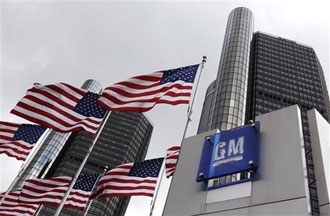GM Predicts $2.1 Bil. Earnings Ahead of IPO
By wchung | 02 Dec, 2025
General Motors Co. is forecasting that it earned as much as $2.1 billion from July to September, a strong financial performance as the company prepares for an initial stock offering on Nov. 18.
The third-quarter earnings, which GM will report next week, bolster the company’s contention that it is leaner and more profitable since restructuring under a government-funded bankruptcy last year.
GM earned $2.2 billion in the first half after it cut brands, lowered debt and offered popular new models of cars and crossovers. Last month, it announced moves to reduce what it owes its pension plans.
GM on Wednesday predicted net income of between $1.9 billion an $2.1 billion in the third quarter and said revenue could reach $34 billion.
“We will deliver a solid and profitable first year post-bankruptcy, and we are continuing to improve our balance sheet and most importantly, the quality of our vehicles,” Chief Financial Officer Chris Liddell said in a statement.
GM’s initial public offering will begin Nov. 18, according to a person familiar with discussions about the IPO.
Under the IPO, three of GM’s four owners — the U.S. government, Canadian and Ontario governments and a union health care trust — will sell 365 million shares, or about a quarter of the company’s outstanding common stock, for between $26 and $29 a share.
That will raise about $10 billion for the owners and allow the largest, the U.S. government, to reduce its stake in the company from 61 percent to just over 40 percent.
The reduced stake is symbolically important for GM, because some Americans resented the company’s taxpayer funded bailout. The perception that GM stood for “Government Motors” has hurt the company’s car sales, GM has claimed.
The U.S. Treasury will sell 264 million shares and will make about $7 billion if the shares sell in the middle of the $26 to $29 price range. The Canadian governments and union trust are expected to make about $3 billion.
Taxpayers got their stake in GM in exchange for giving it $50 billion to survive bankruptcy protection last year. GM has reduced what it owes the government to about $40 billion.
After the IPO, GM would still owe U.S. taxpayers around $33 billion. The government hopes to get the balance back in several follow-up stock sales.
That’s possible over the next three years, but GM would have to perform extraordinarily well during that time, said Joe Phillippi, president of AutoTrends Consulting LLC in Short Hills, N.J.
It’s more likely, he said, that the government will get only a portion of its $33 billion back. “They’re probably an odds-on favorite of getting at least half back over time,” he said.
Guy LeBas, chief fixed-income strategist for Janney Capital Markets, said there’s a 50-50 chance that the government will get its investment back, and any loss would be relatively small.
“The downside is not that large,” he said, estimating that even under poor stock market conditions, the government would lose about $10 billion of its total investment.
The Obama administration has said the aid to GM was necessary to hold off a potential loss of one million jobs and economic devastation in the industrial Midwest.
In the IPO, GM will not sell any common stock, but it plans to raise $3 billion by selling 60 million preferred shares for $50 each. The preferred shares pay a set dividend and become common stock in three years. GM will use the money to shore up its pension plans and pay debt.
___
Associated Press Writer Ken Thomas in Washington and AP Auto Writer Sharon Silke Carty in Detroit contributed to this report.
DETROIT (AP)

Five percent of General Motors' common shares are being set aside for employees and dealers to buy in the company's initial stock sale. (AP Photo/Paul Sancya, file)
Asian American Success Stories
- The 130 Most Inspiring Asian Americans of All Time
- 12 Most Brilliant Asian Americans
- Greatest Asian American War Heroes
- Asian American Digital Pioneers
- New Asian American Imagemakers
- Asian American Innovators
- The 20 Most Inspiring Asian Sports Stars
- 5 Most Daring Asian Americans
- Surprising Superstars
- TV’s Hottest Asians
- 100 Greatest Asian American Entrepreneurs
- Asian American Wonder Women
- Greatest Asian American Rags-to-Riches Stories
- Notable Asian American Professionals

